At the stand of the Moscow Motor Show for the second time, the most popular, judging by polls on the Internet, new product from AvtoVAZ was presented - the Lada Vesta SV in the cross version. The world first saw this car at the Moscow Off Road Show 2015. Spectators of the autumn auto show in 2016 again witnessed the presentation of this model in the concept version. This fact confirms the inevitability of the launch of the new Vesta into mass production in the near future. According to AvtoVAZ representatives, serial production will be launched in the second half of 2022. Let's take a closer look at the new product from Tolyatti.
Main differences
In reality, the cars are very similar, especially when it comes to interior and exterior design. Virtually no changes in the interior. All the main differences relate to technical characteristics, equipment and price.
Salon design and interior
There are also differences in design. Cross models are distinguished by the fact that on the sills, arches and bumpers there is a plastic body kit with protection from scratches and chips. An individual bright orange has appeared in the color line, like the “cross Kalina”. What both models have in common are roof rails on which a luggage rack can be attached. Another detail of the image is the decorative nozzle on the exhaust pipe.
The interior has many almost identical parts, but there are many interesting solutions that make the “cross” version stand out. The interior of the new product is made more interesting and brighter, and all thanks to the decorative trim. At the same time, there are additional options, the installation of which is not provided for on the SV. However, all decorative differences can be ordered separately on the SV.
The main differences in the cabin are as follows:
- original interior lighting;
- light and rain sensor;
- use of combined eco-leather and fabric in seat upholstery;
- heated windshield;
- the inscription on the dashboard Cross;
- LED lighting in the front doors and interior;
- decorative bright inserts;
- use of climate control.
In all other respects, there are no differences in the interior of both models. In general, all the differences in the interior are only that the decorative parts are made in the color of the body.
Difference in car sizes
Naturally, both modifications are very similar in appearance. But there is a certain difference regarding the dimensions. So “Cross” is a little longer, wider and higher (4424x1785x1532) than “SV” (4410x1764x1512). At the same time, the mass did not change - 1280-1350 kg. The ground clearance has also been increased, which is 203 mm compared to the previous 178 mm.
Luggage compartment differences
The luggage compartment volume in both models is 480 liters, which is average for station wagons. The useful volume could be larger, but it is reduced by an organizer with various shelves and niches that are used to store various small things. The organizer is convenient for neatly arranging, securing and transporting small loads.
However, if you need to transport large items, then it will be completely useless. In general, it takes up quite a lot of free space and raises the floor.
To really get the full claimed 480 liters you will need to remove this organizer.
Suspension, transmission, price
The changes also affected the wheels; in the modified version they put 205/50 R17, and in the regular model they offer 195/55 R16 and 185/65 R15. In the rear suspension of the SW, they installed station wagon springs, which are 9 mm larger than those of the sedan, the Cross has completely different springs and shock absorbers, the suspension settings have been changed, and the track has become wider by 14 mm, the suspension has been retuned
The choice of transmission for the Cross is smaller than in the SW. For the city station wagon, the manufacturer offers 4 transmission options – 2 manual and 2 automatic. The “cross” version does not have a 1.6 liter engine option with a robotic transmission. In other words, the regular version is offered with a range of four engines, while the all-terrain model offers only three.
It’s not surprising that the Cross is more expensive than the regular SV version. If you don’t want to overpay and you are quite satisfied with the characteristics of the city version, then you can purchase it for 640 thousand rubles, and the maximum price tag will be 805 thousand rubles. But the price for the “cross” version starts at 756 thousand rubles. and reaches 848 thousand rubles.
Features of the Lada Vesta Cross Concept
The all-terrain Lada Vesta Cross Concept shown in the photo was built by the automaker practically “from scratch,” and relative to the usual Vesta variation, the car received 320 unique components in its design implementation. In addition, the newly-minted off-road vehicle received a plastic protective body kit and increased ground clearance, but initially the station wagon will be produced only in a single-wheel drive version.
The characteristics of the Lada Vesta Cross Concept recorded in the video will be implemented by power plants similar to those of the Vesta sedan, represented by 1.6-liter gasoline engines with an output of 106,114, 87 horses. They will be aggregated with a robot or mechanics. Also in the future, it is likely that a variation with VAZ’s new 126-horsepower 1.8-liter engine will appear in the off-road vehicle’s engine line, which should debut on XRay.
Subsequently, the Lada Vesta Cross Concept, the world premiere of which has already taken place, should receive an all-wheel drive system, which is currently being developed by AvtoVAZ engineers for the XRay crossover. In general, the presented all-terrain new product, according to Bo Andersson, who is the head of AvtoVAZ, is presented to the public to study the reaction of potential consumers to models of a similar segment, on the basis of which a decision will be made on the possibility of the model entering the assembly line.
Returning to the features of the newly-minted all-terrain vehicle, it is worth noting that the car is built on a new chassis independently developed by specialists from the Volzhsky Automobile Plant, borrowing some components from the Renault-Nissan alliance, including steering, brakes and a torsion beam.
Also, the car, by analogy with the sedan, should receive three equipment options: Luxury, Classic and Comfort. The basic variation of the car will be equipped with electric power steering, ABS, a pair of airbags, a stabilization system and air conditioning. In more advanced trim levels, you will find a rear view camera, cruise control, 16-inch alloy wheels, light and rain sensors, an electrically heated windshield and a multimedia system with navigation and a seven-inch display. Additionally, option packages will be offered to improve the car’s equipment, for example, with body stickers, pedal covers, an exhaust pipe tip or a spoiler.
Conclusion
With the Vesta sedan costing around half a million rubles, the price of the Lada Vesta Cross Concept should be only slightly higher than this figure. The appearance of the all-terrain station wagon at dealers should be expected at the turn of 2016-2017.
Lada Vesta Cross Concept video review
The same rake? Or not at all?! Lada Vesta SW Cross – review and test drive
100 certificates from Uremont for 5000 rubles: Subscribe: ...
Is it profitable to buy Vesta?
Prices for the Lada Vesta turned out to be noticeably higher than expected: at least 514 thousand rubles for the initial version of the Classic. However, there will be no completely empty configurations - this market segment is reserved for Granta and Datsun. And the base Vesta is equipped with a VAZ 1.6 sixteen-valve engine (106 hp).
), one airbag, ABS, stabilization system, front electric windows, central locking and steering wheel adjustment for height and reach. But competitors of foreign brands cost about the same! Hyundai Solaris 1.4 (107 hp.
) without ESP, but with two airbags, thanks to discounts, it is now even cheaper - only 506 thousand rubles. The second-generation Renault Logan in a similar Confort configuration with an eight-valve 1.6 engine (82 hp) is only 4,000 rubles more expensive than the Vesta, and for the Volkswagen Polo 1.6 (90 hp)
) you will have to pay an additional 11 thousand rubles.
However, Vesta in the Classic version will not hit the market right away, closer to spring, and the share of such cars in total sales, according to VAZ estimates, will be about 15%. And first of all, sedans in the “medium” Comfort configuration appeared at dealers, which should satisfy 65% of demand. And as the price level rises, purchasing Vesta becomes more and more profitable compared to its competitors.
A “comfortable” Vesta with an audio system, Bluetooth connection, heated front seats, electric drive and heated mirrors, height adjustment of the driver’s seat and rear parking sensors is estimated at 570 thousand rubles. Renault Logan costs almost the same, but without parking sensors and ESP, Solaris is 20 thousand more expensive, and Kia Rio and Volkswagen Polo are 40 thousand rubles more expensive.
And the top version Luxury, which is expected to account for the remaining 20% of demand, looks the most attractive compared to its competitors.
This Vesta with improved interior trim, rear electric windows, light and rain sensors, fog lights and 16-inch wheels costs 609 thousand rubles, and if you add a multimedia system with a rear view camera - 628 thousand.
But Vesta is not without eccentricities. It will have climate control and side airbags only in April - and this, of course, will affect prices. There is no leather steering wheel or curtain airbags at all.
And AvtoVAZ never introduced the promised five-year warranty. Now Vesta is covered by a warranty for three years or 100 thousand km, although the conditions for the Rio/Solaris twins are five years or 150 thousand km.
Well, I don’t recommend Vesta with a “robot” at all: compared to traditional “automatic” cars, its single-clutch gearbox is slow and uncomfortable.
For comparison, a Solaris with a four-speed automatic transmission cannot be purchased for less than 614 thousand, and a Polo with a six-speed gearbox is priced at least 649 thousand rubles.
Which segment will the new Vesta represent?
Not only the appearance and chassis of the car, but also its name will help you understand this issue. The abbreviation SW stands for Station Wagon in English. This is what station wagons were called in America, Australia and New Zealand, which carried passengers along with their luggage from wagons to railway stations.
This suggests that the new modification of Vesta is, first of all, a station wagon. And the prefix Cross is used in the case of off-road vehicles. That is, we are dealing with a potential representative of two segments: station wagon and crossover.
Still, while Vesta has a great length, a fairly roomy trunk and a spacious interior, this car has adopted many more qualities from sports SUVs. It is clear to the naked eye that the designers, even with the smallest details, tried to give the outwardly aggressive character and essence of the predatory crossover Lada Vesta. Moreover, if the car comes in a 4x4 version.
And yet, this model is not an SUV in its purest form. The combination of qualities of this car allows it to please both fans of family driving and off-road driving in the market, which, of course, is a huge plus for the sales of the model and the profitability of AvtoVAZ.
LADA Vesta SW Cross configurations and prices
Select a package to view the basic and additional equipment that is included in it.
- Vesta SW Cross
- Vesta
- Vesta Cross
- Vesta SW
- Vesta Sport
| Equipment | Body | Engine | Power | Box | Drive unit | Overclocking | Speed | Consumption | Price |
| Comfort | Station wagon | gasoline 1.6 l. | 106 hp | M.T. | Front | 12.6 sec. | 178 km/h. | 9.7 | 6.0 | 7.5 | 866 900 |
| Comfort | Station wagon | gasoline 1.8 l. | 122 hp | M.T. | Front | 11.2 sec. | 180 km/h. | 10.7 | 6.4 | 7.9 | 891 900 |
| BLACK | Station wagon | gasoline 1.6 l. | 106 hp | M.T. | Front | 12.6 sec. | 178 km/h. | 9.7 | 6.0 | 7.5 | 901 900 |
| Luxe | Station wagon | gasoline 1.6 l. | 106 hp | M.T. | Front | 12.6 sec. | 178 km/h. | 9.7 | 6.0 | 7.5 | 919 900 |
| Luxe | Station wagon | gasoline 1.8 l. | 122 hp | M.T. | Front | 11.2 sec. | 180 km/h. | 10.7 | 6.4 | 7.9 | 944 900 |
| Comfort | Station wagon | gasoline 1.6 l. | 113 hp | CVT | Front | 12.2 sec. | 170 km/h. | 9.6 | 6.1 | 7.4 | 951 900 |
| Luxe Multimedia | Station wagon | gasoline 1.6 l. | 106 hp | M.T. | Front | 12.6 sec. | 178 km/h. | 9.7 | 6.0 | 7.5 | 960 900 |
| Luxe Multimedia | Station wagon | gasoline 1.8 l. | 122 hp | M.T. | Front | 11.2 sec. | 180 km/h. | 10.7 | 6.4 | 7.9 | 985 900 |
| BLACK | Station wagon | gasoline 1.6 l. | 113 hp | CVT | Front | 12.2 sec. | 170 km/h. | 9.6 | 6.1 | 7.4 | 986 900 |
| Luxe | Station wagon | gasoline 1.6 l. | 113 hp | CVT | Front | 12.2 sec. | 170 km/h. | 9.6 | 6.1 | 7.4 | 1 004 900 |
| Luxe Prestige | Station wagon | gasoline 1.8 l. | 122 hp | M.T. | Front | 11.2 sec. | 180 km/h. | 10.7 | 6.4 | 7.9 | 1 007 900 |
| Luxe Multimedia | Station wagon | gasoline 1.6 l. | 113 hp | CVT | Front | 12.2 sec. | 170 km/h. | 9.6 | 6.1 | 7.4 | 1 045 900 |
| Luxe Prestige | Station wagon | gasoline 1.6 l. | 113 hp | CVT | Front | 12.2 sec. | 170 km/h. | 9.6 | 6.1 | 7.4 | 1 067 900 |
The table contains the following data: name of the configuration, body, its engine (fuel, volume, power). Gearbox (MT - mechanical, AT - automatic, AMT - robotic, CVT - variator). Acceleration from 0 to 100 km/h. Maximum vehicle speed. Fuel consumption per 100 km in liters (in the city | on the highway | in the combined cycle). Manufacturer's recommended price for a new car (may not be current, check with an official dealer). Official dealers and car showrooms where you can buy LADA Vesta SW Cross: LADA dealership centers
Outer shell, design
The front end of this car has a new, powerful and expressive design. The X-shaped style, characteristic of the Vesta model line, is still visible, which is familiar to drivers from the sedan version. But the front bumper in this case is more massive and immediately catches the eye, which gives reliability and a more pronounced perception of the Cross version.
The car has increased ground clearance. This predicts its developed maneuverability in conditions requiring increased cross-country ability. The SV Cross is significantly different from other VAZ models; it has characteristic features, for example, noticeably enlarged wheel arches, a large wheel diameter, and an additional rubberized side strip (molding), part of which is built into the doors. The large wheel arches look especially good when looking at the front of the car from the front. These features give the car a completely different character. And the molding and bumpers not only emphasize the external image of the crossover, but also protect the lower edges of the body from damage.
The proportions of the Lada Vesta SW are also different from those of the sedan. The rear of the car has a very dynamic profile. The roof closer to the trunk is sloped and turns into a larger spoiler, thereby improving the aerodynamic qualities of the station wagon and making it look more sporty. The emphasis on sport is enhanced by the rear bumper and its protective plastic part. The design of the rear pillar resembles the fin of a predator, which, closer to the center, smoothly turns into the very letter “X” that forms the basis of the design of both this modification of Vesta and the previous one. The roof is dark in all body color options. Along the top there are immediately built-in roof rails for attaching the luggage rack.
What's in the cabin?
The interior of the Cross model can hardly be called luxurious; the basic equipment of the car is devoid of many options. However, you feel comfortable in the cabin, and all controls are at hand (see photo of the cabin). Moreover, despite the external asceticism, the ergonomics remain decent. The three-spoke steering wheel looks nice, and the seat materials are non-staining and durable.
There is enough space behind the wheel of the Lada Vesta Cross, and there are enough adjustments even for tall drivers. The profile of the seats is normal, except that the lateral support is quite “liquid” and I would like the lumbar support to be more reliable.
Subjective disadvantages and disadvantages of Lada Vesta Cross 2022 - 2018
The most serious drawback is the robot box, which is currently being installed on the assembly line and which migrated here from Priora. Yes, AvtoVAZ said that they completely redesigned it and tuned it.
But in fact, everything remained unchanged. Both on Priora and on Vesta. The robot also delays with switching, it can freeze, it can switch too early, so that the car nods. I read a lot on forums that the robot is adaptive and over time adapts to the driver’s driving style. But this didn’t happen to me. IMHO, mechanics, in this case, is the most preferable option.
The second disadvantage of the Lada Vesta SV Cross is that the suspension is very noisy. Now I’m not talking about specific breakdowns, when you change something and the noise disappears. It's all about the work itself. Even a fully operational car that rolls off the production line immediately starts to become noisy when entering the highway. Yes, if you moved from nine, you will feel progress and quiet operation of the suspension. And if you moved from the same Kia Rio or Solaris, which are Vesta’s classmates, you will undoubtedly understand that Vesta is much noisier.
The third subjective drawback of the Lada Vesta SV Cross is poor sound insulation. In the cabin you can hear the noise of the wheels, all the joints and unevenness of the road very well. And also a lot of crickets. Many Vesta sedan and station wagon owners simply coat the car with sound insulation immediately after purchase.
Next we move on to ergonomics. As for me, the controls for the power windows and heated seats are not very conveniently located. The power windows do not have an automatic mode. The seat belts are not located quite correctly, which is why it is not as convenient to fasten as in most foreign cars. Although over time you get used to it. If the steering wheel is made of imitation leather, it is not very comfortable, since in the heat your hands sweat and it becomes slippery.
Prices for all LADA cars
| 4×4On sale | from 587,900 rub. |
| 4x4 5 doors On sale | from 630,900 rub. |
| 4x4 BrontoOn sale | from 742,900 rub. |
| 4×4 UrbanOn sale | from 663,900 rub. |
| 4×4 Urban 5 doorsOn sale | from 706,900 rub. |
| NivaOn sale | from 738,000 rub. |
| XRAYOn sale | from 660,900 rub. |
| XRAY CrossOn sale | from 810,900 rub. |
| GrantaOn sale | from 488,900 rub. |
| Granta Drive ActiveOn sale | from 672,900 rub. |
| VestaOn sale | from 676,900 rub. |
| Vesta CrossOn sale | from 823,900 rub. |
| Vesta SportOn sale | from 1,089,900 rub. |
| Granta SportArchive | from 554,900 rub. |
| PrioraArchive | from 424,900 rub. |
| Granta CrossOn sale | from 603,900 rub. |
| Granta Station WagonOn sale | from 515,900 rub. |
| LargusOn sale | from 653,900 rub. |
| Largus CrossOn sale | from 813,900 rub. |
| Vesta SWOn sale | from 759,900 rub. |
| Vesta SW CrossOn sale | from 866,900 rub. |
| Kalina UniversalArchive | from 475,200 rub. |
| Priora UniversalArchive | from 443,000 rub. |
| Largus VanOn Sale | from 640,900 rub. |
| Granta LiftbackOn sale | from 507,900 rub. |
| Granta HatchbackOn sale | from 505,900 rub. |
| KalinaArchive | from 460,600 rub. |
| Kalina CrossArchive | from 545,800 rub. |
| Kalina SportArchive | from 576,900 rub. |
| Priora HatchbackArchive | from 443,000 rub. |
Sedan capabilities
After a test drive of the car was carried out in the city and on the highway, it was decided to drive on a country road. And due to the almost 18 cm of ground clearance, we were able to easily drive in those places where the Rio and Solaris began to touch the ground with their bottoms. Vesta, practically without slowing down, drove along a very deep rut, while the SUV drivers in front were in bewilderment when the domestic Lada Vesta blinked its headlights behind them. Carrying out such a very extreme test drive for the sedan, we understood that there was a high probability that a tow would be needed, but the car continued to calmly cope with the assigned tasks.
Moving along the highway, the car holds well at high speeds, so before even a strong climb, you can not be afraid to accelerate and go into third gear. By the way, on the new Lada, we had to feel the traction control system only once, when we missed a necessary turn. Therefore, the pre-prepared shovel and the accompanying SUV for towing never had to be used.
When we returned to the city, all test drive participants came to a unanimous opinion about the car. It really is worth the price. By the way, we recommend that off-road enthusiasts take care in advance about installing good crankcase protection. The factory installed option does not have the required level of protection and therefore stones can damage the engine.
Expected characteristics
There is no precise information yet regarding the technical parameters of SW Cross. Experts predict that the new Lada will have three different variations of a 1.6-liter gasoline engine. They will approximately have outputs of 87, 106 and 114 horsepower. Today, the AvtoVAZ company practices introducing a production trend for each subsequent designed car with a 1.8-liter unit. Most likely, the Lada SV will fall under this trend and we will see a more powerful Vesta.
Options and prices
Comfort
Lada Vesta SW Cross with a base engine in the standard Comfort configuration with 106 horsepower costs 906,000 rubles. The same variation with a 122 hp engine. valued at 930,000 rubles. The Comfort package will cost the most with a 113-horsepower engine and a CVT. The price of this combination is 991,000 rubles.
When purchasing a Lada Vesta SW Cross, the car will be supplied on 17-inch aluminum wheels. The optics are completely halogen, but front and rear fog lights are standard. Turn signal repeaters are built into the side mirrors. In addition, they are electrically heated and can be conveniently adjusted using a servo drive. Additional decorative elements in the exterior of the cross-station wagon include roof rails and a rear spoiler.
The salon has a combined upholstery as standard. In addition to the fact that the seats are electrically heated as standard, they have good lumbar support. Due to the fact that the driver's seat has a number of different adjustments, including height, as well as the ability to adjust the steering wheel not only by the angle of inclination, but also by reach, the driver will be able to choose the optimal position for himself for a comfortable and not tiring ride. At the same time, switching your favorite audio tracks from the multifunction steering wheel will ensure maximum safety and reduce unnecessary movements during the trip.
Despite the fact that full climate control is not available in this configuration, it boasts a pre-installed air conditioner, which is controlled from a unit located on the center console. In addition, the Comfort modification is equipped with a standard audio system, represented by a radio with support for radio, MP3, 4 speakers, USB, AUX and SD cards. Additional equipment of the Lada Vesta SW Cross includes a functional box in the trunk, as well as a curtain. There is a full-size spare wheel in a special niche in the luggage compartment. Electric windows are available not only to those sitting in the front of the Lada Vesta SW Cross. They are also in the back row.
Safety systems in the Comfort package include:
- frontal airbags;
- ISOFIX mount;
- ERA-GLONASS system;
- three-point seat belts;
- ABS;
- ESP;
- brake force distribution system;
- auxiliary braking system;
- turning on the hazard warning lights automatically during emergency braking;
- traction control system;
- hill start assist system;
- Cruise control;
- automatic door locking while driving;
- rear parking sensor.
Luxe
Prices for the Luxe package start from 959,000 rubles and reach their peak at around 1.107 million rubles. The fact is that this modification is offered with various optional packages. But as standard, its main differences from the Comfort version are the presence of rain and light sensors. Moreover, instead of 4 headrests, there are already 5 in the cabin. In addition to the side airbag, the safety systems are supplemented with the “walk me home” function, as well as dynamic cornering lighting.
Instead of an air conditioner, this configuration has a full-fledged climate control system, and additional lighting comes on when entering the cabin. By paying 44,000 rubles, the buyer activates the Multimedia package. In addition to the 7-inch touchscreen multimedia system with a rear camera, it also includes a leather-wrapped steering wheel and an electrically heated steering wheel. In addition, the version with a CVT in the Luxe configuration is also equipped with a special Prestige package. It includes LED ambient lighting, as well as heated first-row seats and a rear dividing armrest.
Drive Rear-wheel drive Number of gears (manual gearbox) 5 Front suspension Independent, McPherson spring, with stabilizer Rear suspension Semi-independent, coil spring Front brakes Disc Rear brakes Disc ABS yes Steering type Steering rack Power steering Electric power steering
Potential competitors of the new SV Cross
To compete in the market of European and American cars, Lada designers need to combine in it:
- high quality car manufacturing;
- creative solutions and introduction of innovations that competitors do not have;
- unique style;
- meeting the demand of most customers;/li>
- lowest possible price.
This model can be simultaneously attributed to two segments of the automotive market. This factor was undoubtedly considered by the creators of the Lada as an advantage. But there is also a drawback to this situation. In the pursuit of buyers for VAZ, crossovers and station wagons from more popular or simply time-tested powerful European concerns will become competitors. That is, the number of opponents increases exactly 2 times. It is proposed to consider which cars from these two segments are most competitive in the fight against the Lada SW Cross.
| Segment | Models |
| Of the options offered on the so-called primary market, that is, of cars produced in 2015, 2016 and 2022, the following cars have the best chance of competing with Vesta. | Ford Focus, Hyundai i30 and KIA Ceed. This refers to modifications of these cars in a station wagon body. As you know, the above-mentioned American and Korean concerns have a good reputation and quality recognized throughout the world. Therefore, AvtoVAZ designers need to take care of the quality level of the car and try to reach a new level. |
| In the secondary station wagon market, Vesta will also need to withstand tough competition. | For the same money you can buy a Chevrolet Cruize, Audi A6 (here the mileage will be higher), Volkswagen Golf, Renault Megane with relatively low mileage. These, again, are representatives of recognized global brands. |
As for the SUV market, the Lada Vesta SW could theoretically compete with the KIA Optima, Hyundai Tuscon and the same Renault Megane. But the off-road market has car prices much higher than the cost of Vesta. If the developers maintain a decent level of quality corresponding to the price, this model has a chance to compete in the crossover market.
Configurations and prices of Lada Vesta SV Cross 2022
The cross country car will be available in 5 different versions. The car in basic equipment will cost 615 thousand rubles. The cost of expensively equipped cars can reach 850 thousand rubles.
| u0412u0435u0441u0442u0430 u041au0430u043du0442u0440u0438 2021 | |
| u041du0430u0437u0432u0430u043du0438u0435 u0432u0435u0440u0441u0438u0438 | u0426u0435u043du0430 |
| Classic se | u041eu0442 615 000 u0440u0443u0431. |
| Classic Start cv | u041eu0442 640 000 u0440u0443u0431. |
| Comfort cw | u041eu0442 668 000 u0440u0443u0431. |
| Luxe ws | u041eu0442 731 000 u0440u0443u0431. |
| Luxe Exclusive xw | u041eu0442 808 000 u0440u0443u0431. |
Interior
The fact that the Skoda has passed the European New Car Assessment Program (Euro NCAP) test, while another competitor has not, makes it extremely safe. However, beyond the official crash test results, there are other things we need to know about.
Salon Skoda Rapid
Both cars belong to the small family car segment, which tends to classify them somewhere in the middle in terms of safety, but that doesn't help us solve our dilemma? Additionally, when it comes to weight, a factor that most people underestimate, the Russian car offers a marginal difference of 1%!more metal.
The dashboard is identical to the earlier Rapid, which in turn is shared with the VW Vento. The design is subdued, but everything is where you'd expect. The centerpiece is the new large and fairly clear 6.5-inch touchscreen with USB, AUX and Bluetooth support, as well as MirrorLink connectivity. Other new equipment includes rain-sensing wipers and electronically folding outside mirrors, which help bridge the gap between the Rapid and better-equipped rivals. Skoda's trademark 'smart features' come in the form of a card holder clip on the center console that stores all your passes and the like.
Frontal visibility for rear passengers is also not the best due to the large front seats. However, the presence of front and rear armrests, unlike the Vesta, is welcome. Other notable equipment includes tilt and telescopic steering, auto-dimming rearview mirror, cruise control, cooled glove compartment, climate control, rear air vent, one-touch power windows and remote windows. However, some features are noticeably missing, such as a rearview camera and an engine start/stop button.
Lada Vesta salon
Speaking of safety, Skoda offers ABS and dual front airbags as standard on all versions of the new Rapid. You also get roll control and electronic stability control with the DSG transmission. Skoda has a bad reputation when it comes to sales, but they have come a long way in making the process transparent and reliable. The car also makes less noise and has better insulation. They also offer a 4-year vehicle servicing program as standard with the new Rapid, which covers 4 years of warranty, 4 years of roadside assistance and an optional 4-year service package.
| Lada Vesta | Skoda Rapid | |
| 2016 | Production | 2017 |
| C | Car class | C |
| Station wagon, 5 doors | Body type | Hatchback, 5 doors |
| Front | Drive unit | Front |
| 4424 mm. | Length | 4483 mm. |
| 1785 mm. | Width | 1706 mm. |
| 1537 mm. | Height | 1461 mm. |
| 480 liters | Trunk (min.) | 550 liters |
| 825 liters | Trunk (max.) | 1490 liters |
| 55 liters | Fuel tank | 55 liters |
| Petrol | Fuel | Gasoline/diesel |
| 4 - Inline, 4 valves per cylinder | Configuration | 4 - Inline, 4 valves per cylinder |
| Naturally aspirated. | Aspiration | Turbo |
| 1774 cc cm. | Volume | 1598 cc |
| 122 l. With. | Power | 115 l. With. |
| 170 Nm | torque | 250 Nm |
| mechanics, 5 gears | mechanics, 5 gears | |
| 1310 kg. | Vehicle weight | 1295 kg. |
| 11.2 s. | Acceleration 0-100 km/h | 10.0 s. |
| 180 km/h | Maximum speed | 201 km/h |
| 10.7 l/100 km | Consumption in the city | 4.7 l/100 km |
| 6.4 l/100 km | Highway consumption | 4.0 l/100 km |
| 7.9 l/100 km | Mixed consumption | 4.2 l/100 km |
| 169 g/km | CO2 emissions | 109 g/km |
| automatic, 5 gears | automatic, 6 gears | |
| 1330 kg. | Vehicle weight | 1265 kg. |
| 13.3 s. | Acceleration 0-100 km/h | 11.8 s. |
| 180 km/h | Maximum speed | 190 km/h |
| 10.1 l/100 km | Consumption in the city | 10.2 l/100 km |
| 6.3 l/100 km | Highway consumption | 6 l/100 km |
| 7.7 l/100 km | Mixed consumption | 7.5 l/100 km |
| US$11,200 | Price from | US$15,100 |
We recommend: Hyundai Porter 2 truck











